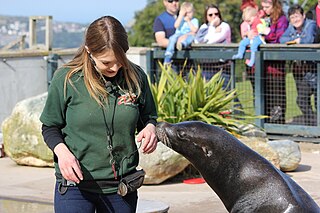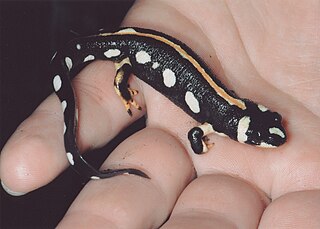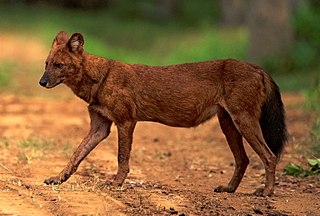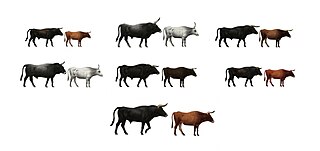
Brisbane Water National Park is a national park on the Central Coast of New South Wales, Australia. The national park is situated 70 kilometres (43 mi) north of Sydney and 12 kilometres (7.5 mi) southwest of Gosford. It consists the Brisbane Water and Mooney Mooney Creek waterways.

Ex situ conservation is the process of protecting an endangered species, variety, or breed of plant or animal outside its natural habitat. For example, by removing part of the population from a threatened habitat and placing it in a new location, an artificial environment which is similar to the natural habitat of the respective animal and within the care of humans, such as a zoological park or wildlife sanctuary. The degree to which humans control or modify the natural dynamics of the managed population varies widely, and this may include alteration of living environments, reproductive patterns, access to resources, and protection from predation and mortality.

Selective breeding is the process by which humans use animal breeding and plant breeding to selectively develop particular phenotypic traits (characteristics) by choosing which typically animal or plant males and females will sexually reproduce and have offspring together. Domesticated animals are known as breeds, normally bred by a professional breeder, while domesticated plants are known as varieties, cultigens, cultivars, or breeds. Two purebred animals of different breeds produce a crossbreed, and crossbred plants are called hybrids. Flowers, vegetables and fruit-trees may be bred by amateurs and commercial or non-commercial professionals: major crops are usually the provenance of the professionals.

Perth Zoo is a 17-hectare (41-acre) zoological park in South Perth, Western Australia. The zoo first opened in 1898 and by 2011 housed 1258 animals of 164 species and an extensive botanical collection. It is a full institutional member of the Zoo and Aquarium Association (ZAA) and the World Association of Zoos and Aquariums (WAZA).

The Mesker Park Zoo and Botanic Garden is a zoo that opened in 1928 in Evansville, Indiana, United States. It is located in Mesker Park on Evansville's northwest side and is run by the City of Evansville.

The Jefferson salamander is a mole salamander native to the northeastern United States, southern and central Ontario, and southwestern Quebec. It was named after Jefferson College in Pennsylvania.
The conservation status of a group of organisms indicates whether the group still exists and how likely the group is to become extinct in the near future. Many factors are taken into account when assessing conservation status: not simply the number of individuals remaining, but the overall increase or decrease in the population over time, breeding success rates, and known threats. Various systems of conservation status are in use at international, multi-country, national and local levels, as well as for consumer use such as sustainable seafood advisory lists and certification. The two international systems are by the International Union for Conservation of Nature (IUCN) and The Convention on International Trade in Endangered Species of Wild Fauna and Flora (CITES).

Captive breeding, also known as captive propagation, is the process of keeping plants or animals in controlled environments, such as wildlife reserves, zoos, botanic gardens, and other conservation facilities. It is sometimes employed to help species that are being threatened by the effects of human activities such as climate change, habitat loss, fragmentation, overhunting or fishing, pollution, predation, disease, and parasitism.

The De Wildt Cheetah and Wildlife Centre, also known as Ann van Dyk Cheetah Centre is a captive breeding facility for South African cheetahs and other animals that is situated in the foothills of the Magaliesberg mountain range in the North West Province of South Africa.

The pygmy hog is a very small and endangered species of pig and the only species in the genus Porcula. Endemic to India, the pygmy hog is a suid native of the alluvial grasslands in the foothills of the Himalayas, at elevations of up to 300 m (980 ft). Populations of pygmy hogs were once widespread in the tall, dense, wet grasslands in a narrow belt of the southern Himalayan foothills from north-western Uttar Pradesh to Assam, through southern Nepal and North Bengal, and possibly extending into contiguous habitats in southern Bhutan. Due to human encroachment and destruction of the pygmy hogs’ natural habitat, the species was thought to have gone extinct in the early 1960s. However, in 1971, a small pygmy hog population was rediscovered as they were fleeing a fire near the Barnadi Wildlife Sanctuary in Assam. Today, the only known population of pygmy hogs resides in Manas National Park in Assam, India. The population is threatened by livestock grazing, fires and poaching. With an estimated population of less than 250 mature individuals, the pygmy hog is listed as an Endangered species on the IUCN Red List, and conservation efforts such as captive breeding and re-release programs are currently being employed.

The Catalina Island Conservancy is a nonprofit organization established to protect and restore Santa Catalina Island, California, United States. The Conservancy was established in 1972 through the efforts of the Wrigley and Offield families. The Conservancy was created when both families deeded 42,135 acres (170.51 km2) of the island over to the organization—88% of the Island.

In biogeography, a native species is indigenous to a given region or ecosystem if its presence in that region is the result of only local natural evolution during history. The term is equivalent to the concept of indigenous or autochthonous species. A wild organism is known as an introduced species within the regions where it was anthropogenically introduced. If an introduced species causes substantial ecological, environmental, and/or economic damage, it may be regarded more specifically as an invasive species.

A zoo is a facility in which animals are kept within enclosures for public exhibition and often bred for conservation purposes.

Neurergus kaiseri, the Luristan newt, Kaiser's mountain newt, Kaiser's spotted newt or emperor spotted newt, is a species of very colourful salamander in the family Salamandridae. It is endemic to the southern Zagros Mountains in Iran where it is known from just four streams. Populations of this newt have been declining and the International Union for Conservation of Nature has rated it as "vulnerable". A captive breeding programme has been established in several zoos.
Genetic erosion is a process where the limited gene pool of an endangered species diminishes even more when reproductive individuals die off before reproducing with others in their endangered low population. The term is sometimes used in a narrow sense, such as when describing the loss of particular alleles or genes, as well as being used more broadly, as when referring to the loss of a phenotype or whole species.
The EAZA Ex-situ Programme (EEP) is a population management and conservation programme by European Association of Zoos and Aquaria (EAZA) for wild animals living in European zoos. The programme was formerly known as the European Endangered Species Programme.

An endangered species is a species that is very likely to become extinct in the near future, either worldwide or in a particular political jurisdiction. Endangered species may be at risk due to factors such as habitat loss, poaching, invasive species, and climate change. The International Union for Conservation of Nature (IUCN) Red List lists the global conservation status of many species, and various other agencies assess the status of species within particular areas. Many nations have laws that protect conservation-reliant species which, for example, forbid hunting, restrict land development, or create protected areas. Some endangered species are the target of extensive conservation efforts such as captive breeding and habitat restoration.

The Lakeland Wildlife Oasis is a small zoological collection near the town of Milnthorpe, Cumbria, England, with a science and evolution theme. Since April 2012 the zoo has been run by the registered charity Lakeland Trust for Natural Sciences.
Crane Conservation Center and Wildlife Park, Lakki Marwat is a conservation center for the captive breeding of various types of wild birds and animal species. It is located west of Kurram River in Lakki Marwat, Khyber Pakhtunkhwa, Pakistan, 250 kilometres (155 mi) south of Peshawar. It was established in 2007. The center is equipped with a total of 15 circular aviaries and 20 cages as well as an education block for visitors. The center is now maintained and operated by Khyber Pakhtunkhwa Wildlife Department through the Bannu Wildlife Division, Bannu while its establishment was funded by WWF - Pakistan, GEF, UNDP and Darwin Initiative.

The Tauros Programme, formerly known as TaurOs Project, is a cooperation between the Dutch foundation Stichting Taurus and universities such as the Wageningen University and Research Centre. It is an international effort to breed a type of cattle that resembles the extinct aurochs, the wild ancestor of domestic cattle.
















